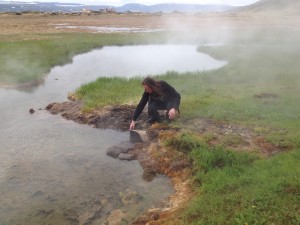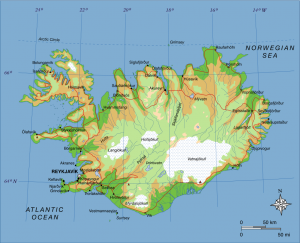23 December 2015
Chemical changes in groundwater precede earthquakes in Iceland, study finds
Posted by Lauren Lipuma
by Erin E.A. Ross
Northern Iceland is a geothermally active land where heat from deep below the crust melts snow and wreaths the land in steam. Now, new research shows that the tumultuous groundwater beneath northern Iceland’s mist may hold the key to predicting future earthquakes in the region. In a new study presented at the 2015 American Geophysical Union Fall Meeting, researchers found that concentrations of dissolved minerals in groundwater sharply increased before two major earthquakes in northern Iceland, possibly offering a strategy for earthquake prediction.
The island nation of Iceland is slowly being torn in half along the boundary between two continental plates: the Eurasian plate to the east and the North American plate to the west. At the northern end of Iceland, near this divide, lies the seismically active Tjörnes Fracture Zone.
Since 2008, scientists from Stockholm University have taken weekly water samples from artesian wells near the fracture zone. From 2008-2015, the researchers saw the amount of dissolved sodium and silicon in the water steadily decrease – except for two drastic increases, one in early 2012 and one in late 2013, said Margareta Andrén, a recent graduate from the Research School for Teachers at Stockholm University and lead author on the study. Each time, the increase was followed four to six months later by a magnitude 5 or higher earthquake, Andrén said.

A map of the 11 volcanic zones of Iceland. The dotted circle is the position of the hypothetical hot spot of Iceland. Abbreviations: Reykjanes Ridge (RR); Reykjanes Volcanic Belt (RVB); Kolbeinsey Ridge (KR); Tjörnes Fracture Zone (TFR); North Volcanic Zone (NVZ); East Volcanic Zone (EVZ); West Volcanic Zone (WVZ); Mid-Iceland Belt (MIB); South-Iceland Seismic Zone (SISZ); Öræfi Volcanic Belt (ÖVB); Snæfellsnes Volcanic Belt (SVB).
Credit: Lanredec via Wikimedia Commons.
According to Andrén, previous studies have found links between the mineral concentrations in groundwater and earthquakes, but the studies have had trouble establishing a correlation. Some only had one earthquake in their data set, or hadn’t measured groundwater long enough to weed out background fluctuations in minerals and ions, she said.
Because the Tjörnes Fracture Zone is very seismically active, Andrén said, the team knew if they monitored groundwater there, the odds of getting an earthquake in their data set were very high. They got two.
Andrén and co-author Alasdair Skelton published an article in Nature Geoscience in September 2014 detailing some of their findings, but they still had unanswered questions. Why did the levels of sodium and silicon decrease over time? What caused the mineral levels to change in the water before the earthquake?
To answer these questions, Andrén’s team returned to the wells in the Tjörnes Fracture Zone. They took 20 drill cutting samples from the walls of the wells, between 36 meters (118 feet) and 96 meters (314 feet) deep, and used them to examine the composition of silicate rocks near the natural water inlets into the wells. They found evidence that labradorite, a common type of volcanic feldspar, was being rebuilt to analcime, a process that normally occurs the presence of water. This could explain the decrease in sodium and silicon over the course of the study, Andrén said.

Alasdair Skelton, a researcher at Stockholm University, samples water near an artesian well in the Tjörnes Fault Zone in northern Iceland.
Credit: Margareta Andrén.
But before an earthquake, the ground warps and bends, Andrén explained. The shifting ground could open up new surfaces to groundwater, causing more water-triggered reactions. Water from older, deeper aquifers could also be mixing with newer water closer to the surface. This influx of new water could explain the chemical changes before the quake, she said.
Regardless of what caused the increase, Andrén is confident mineral changes in groundwater may preclude earthquakes in this part of Iceland, and possibly elsewhere in the world.
“Having two earthquakes makes us very confident in our data,” Andrén said. Still, she cautioned, this doesn’t mean we can predict earthquakes… yet. “We need more samples to do that.”
– Erin E.A. Ross is a science communication graduate student at UC Santa Cruz. Follow her on Twitter at @erineaross.











 GeoSpace is a blog on Earth and space science, managed by AGU’s Public Information staff. The blog features posts by AGU writers and guest contributors on all sorts of relevant science topics, but with a focus on new research and geo and space sciences-related stories that are currently in the news.
GeoSpace is a blog on Earth and space science, managed by AGU’s Public Information staff. The blog features posts by AGU writers and guest contributors on all sorts of relevant science topics, but with a focus on new research and geo and space sciences-related stories that are currently in the news.